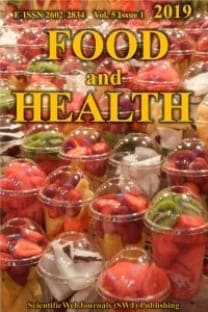Antioxidant activity of the fruits of Pyracantha coccinea using ethanolic extract method
___
Al Shaal, S., Karabet, F., Daghestani, M. (2019). Determination of the antioxidant properties of the Syrian olive leaves extracts and isolation oleuropein by HPLC techniques. Analytical and Bioanalytical Chemistry Research, 6(1), 97-110. https://doi.org/10.22036/ABCR.2018.137753.1220Blois, M.S. (1958). Antioxidant determinations by the use of a stable free radical. Nature, 181, 1199-1200. https://doi.org/10.1038/1811199a0
Do, Q.D., Angkawijaya, A.E., Tran-Nguyen, P.L., Huynh, L.H., Soetaredjo, F.E., Ismadji S, Ju Y. (2014). Effect of extraction solvent on total phenol content, total flavonoid content, and antioxidant activity of Limnophila aromatic. Journal of Food and Drug Analysis, 22, 296-302. https://doi.org/10.1016/j.jfda.2013.11.001
Ebrahimzadeh, M.A., Pourmorad, F., Hafezi, S. (2008). Antioxidant activities of Iranian corn silk. Turkish Journal of Biology, 32, 43-49.
Fico, G., Bilia, A.R., Morelli, I., Tome F. (2000). Flavonoid distribution in Pyracantha coccinea plants at diferent growth phases. Biochemical Systematics and Ecology, 28, 673-678. https://doi.org/10.1016/S0305-1978(99)00109-X
İnceçayir, D., Semerci, A.B., Mustafa, N., Tunç, K. (2019). Catalpa bignonioides metanolik çiçek ekstraktının biyolojik ve kimyasal aktivitesi. Türk Tarım ve Doğa Bilimleri Dergisi, 6(2), 230-234. https://doi.org/10.30910/turkjans.557101
Kambur, S., Tilki, F. (2010). Pyracantha coccinea Roem. tohumunun çimlenme özelliklerinin belirlenmesi. III. Ulusal Karadeniz Ormancılık Kongresi 20-22 Mayıs 2010 Cilt: II Sayfa: 785-791.
Keser, S. (2014). Antiradical activities and phytochemical compounds of firethorn (Pyracanthacoccinea) fruit extracts. Natural Product Research, 28(20), 1789-1794. https://doi.org/10.1080/14786419.2014.942304
Kumar, S., Yadav, A., Yadav, M., Yadav, J.P. (2017). Effect of climate changeon phytochemical diversity, total phenoliccontent and in vitro antioxidant activity of Aloevera (L.) BMC Research Notes, 10, 60. https://doi.org/10.1186/s13104-017-2385-3
Mouafo Tekwu, E., Costant Pieme, A., Penlap Beng, V. (2012). Investigations of antimicrobial activity of some Cameroonian medicinal plantextracts against bacteria and yeast with gastrointestinal relevance. Journal of Ethnopharmacology, 142, 265-273. https://doi.org/10.1016/j.jep.2012.05.005
Mustafa, R.A., Abdul Hamid, A., Mohamed, S., Abu Bakar, F. (2010). Total phenolic compounds, flavonoids, and radical scavenging activity of 21 selected tropical plants. Journal of Food Science, 75, 28-35. https://doi.org/10.1111/j.1750-3841.2009.01401.x
National Committee for Clinical Laboratory Standards (1997). Performance standards for antimicrobial disk susceptibility tests. Approved standard M2-A6. Wayne, Pa: National Committee for Clinical Laboratory Standards; 1997.
Niciforovic, N., Mihailovic, V., Maškovic, P., Solujic, S., Stojkovic, A., Pavlovic, DM. (2010). Antioxidant activity of selected plant species; potential new sources of natural antioxidants. Food and Chemical Toxicology, 48, 3125-3130. https://doi.org/10.1016/j.fct.2010.08.007
Oyaizu, M. (1986). Studies on product of browning reaction prepared from glucose amine. Japanese Journal of Nutrition, 44, 307-315. https://doi.org/10.5264/eiyogakuzashi.44.307
Parka, J., Rhob, S.-J., Kima, Y.-R. (2019). Enhancing antioxidant and antimicrobial activity of carnosic acid in rosemary (Rosmarinus officinalis L.) extract by complexation with cyclic glucans. Food Chemistry, 299, 125119. https://doi.org/10.1016/j.foodchem.2019.125119
Sadeghi, Z., Valizadeh, J., Azizian Shermeh, O., Akaberi, M. (2015). Antioxidant activity and total phenolic content of Boerhavia elegans (choisy) grown in Baluchistan, Iran. Avicenna Journal of Phytomedicine, 5(1), 1-9.
Sarıkürkçü, C., Tepe, B. (2015). Biological activity and phytochemistry of firethorn (Pyracantha coccinea M.J. Roemer). Journal of Functional Foods, 19, 669-675. https://doi.org/10.1016/j.jff.2015.10.004
Singleton, V.L., Rossi, J.A. (1965). Colorimetry of total phenolics with phosphomolybdic-phosphotungstic acid reagents. American Journal of Enology and Viticulture, 16, 144-158.
Ucar-Türker, A., Birinci-Yildirim, A., Pehlivan-Karakas, F. (2012). Antibacterial and antitumor activities of some wild fruits grown in Turkey. Biotechnology & Biotechnological Equipment, 26(1), 2765-2772. https://doi.org/10.5504/BBEQ.2011.0156
Vahabi, L., Monajemi, R., Shahanipou, K., Moridnia, A., Mortazavifar, F. (2014). Studying the cytotoxic effect of methanolic extract of Pyracantha coccinea M. Roemer fruit on HeLa cell line and antioxidant capacities and total phenol contents of methanolic and aquatic extract of this fruit. Bulletin of Environment, Pharmacology and Life Sciences, 8, SEMAR. https://doi.org/10.13005/bpj/564
Zou, Z., Xi, W., Hu, Y., Nie, C. Zhou, Z. (2016). Antioxidant activity of citrus fruits. Food Chemistry, 196, 885-896. https://doi.org/10.1016/j.foodchem.2015.09.072
- ISSN: 2602-2834
- Yayın Aralığı: Yılda 4 Sayı
- Başlangıç: 2018
- Yayıncı: ScientificWebJournals (SWJ) Özkan Özden
Fatma KANDEMİRLİ, NESRİN İÇLİ, Temel Kan BAKIR, Bahar NAZLI, Serap AYDIN
Consumer perceptions of food safety of fried mussel: multiple correspondence analysis
DEMET KOCATEPE, B. Barış ALKAN, İrfan KESKİN, Yalçın KAYA
Türkiye ve Avrupa Birliği’nde tüketicilerin gıda güvenliğiyle ilgili tutum ve davranışları
The quality of ice cream samples made from buffalo milk
Hatice BEKİROĞLU, Salih ÖZDEMİR
Tahıl benzeri ürünler: Bileşimi, beslenme-sağlık üzerine etkileri ve tahıl ürünlerinde kullanımı
Sokakta satışa sunulan geleneksel Kadirli sucuğunun mikrobiyolojik kalitesi
EMEL ÜNAL TURHAN, Hatice DEMİR, Rabia PÜSKÜLLÜ, Merve KÖR, Uğur ZENGİN
Antioxidant activity of the fruits of Pyracantha coccinea using ethanolic extract method
